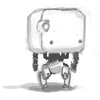Navigation and Wayfinding in a "Dark Game" - Part 1
When building a game that takes place primarily in the dark, how do traditional level design principles change? This post is part one of how PixelBot Games had to make alterations to CANARI after players struggled with finding their way.

For the next few posts, I will be exploring some plans I've come up with to make CANARI more approachable to new players without giving away my original "exploration in the dark" goals. If you are building a dark game, hopefully some of these tips will help you. If you have any tips to add of your own, please leave a comment or drop me a line, craig at pixelbotgames dot com!
![]()
In case this happens to be your first time hearing about CANARI, its a dual stick action rogue-lite that takes place primarily in the dark. That's no problem for the player as his/her job is to pilot LUMIN, a light utility robot that has crash landed on a hostile planet. Our game features an energy conservation mechanic that requires players to spend energy to use tools that help them light their way. Watching a video of gameplay should fill in any gaps you might have as to what I'm talking about.
"So... is there like a map or something?" -- Every Player
Since CANARI is predominately played "in the dark", traditional methods of level design in regards to navigation go out the window. Additionally, our game is procedurally generated where we use a few art assets quite a bit over and over in various permutations to give the appearance of an organic structure.
CANARI has gone procedural folks. Can't wait to share the new demo. #screenshotsaturday #madewithunity #indiedev pic.twitter.com/1w7mnzba9e
— PixelBot Games (@PixelBotGames) October 3, 2015
The result is a game that utilizes a top down camera, on art assets that while very pretty look very much the same from room to room, combined with very little visibility distance. Oh, and its in 3d. Yikes! After getting a rather large set of new players through CANARI while showing at this years MAGFest, it became apparent that new players were getting lost on the second and third stages of the demo. Exploration has always been a design pillar for CANARI, but some players were simply quitting after getting lost while backtracking. The punishing nature of a difficult rogue-lite combined with the requirement to remember the path you took is seemingly a bit much in a 11-16 room dungeon (at least as the second challenge in a demo).
Reduce the size of the initial levels
Our current configuration of procedural room definitions usually populates levels that average 9 rooms for the first level, 12 rooms for the second, and 18 rooms for the third. By reducing the room sizes down to 6, 9, 12 respectively I believe I've been able to keep the feeling of an expansive world (the dark really lets the mind wander) without sacrificing the need for players to explore the edges of the map. It's interesting how our brains fill in the gaps when we are void of information. While playtesting, I know how large the space is, but first timers seem to imagine the layout to be much larger than it is. I've seen people lost in 3 rooms.
"Weenies" in procedurally generated levels
There is a very famous video in the GDC Vault: Everything I Learned about Level Design I Learned From Disneyland by Scott Rodgers that every aspiring level designer should watch. It teaches us how important landmarks are to human navigation. The same holds true in game worlds. Weenies are large themed objects that tie into the surrounding area and provide context for the environment and point to point wayfinding. How do you create a landmark, when your props are being splattered over the environment over and over? In the context of proc gen level design, its important to remember that models can be made to look unique and be reused. For CANARI, that means decorating rooms in layers. Our base layer consists of objects that can be reused throughout many elevations of the game world. These objects consist of stalactites and stalagmites, rocks, boulders, mounds, etc. These larger-scale items are eye catching and easy to remember. Scale is the important word here. A player might say to themselves, "Oh, right this is the room with the double stalactite piercing through the ceiling." By utilizing scale effectively, we can generate "weenies" out of our model library. Then, we take a second layer of decorations that are used to theme the area.
![]()
In CANARI, players are traveling deeper into the basin of an underground cavern system. As they go deeper, the environment shifts from the cold desolate surface, to a dusty web filled spider haven, to a balanced temperate climate where alien vegetation has begun to grow, and so on (eventually). The second layer of decoration uses the base layer and themes it based on player progression. For instance, a series of webbing can be overlaid on base mesh rocks and boulders that were previously used on the surface environment. Utilizing texture changes, scale adjustments and rotations, assets can easily be repurposed. A final layering of assets can be useful in digetic storytelling. What is this space used for? Is this a hive/birthing room or where the swarm devours its prey? This allows us to keep our art costs down, but the player feels as though they are progressing into new territory with equally new challenges and mechanics. We will pick up this conversation next time with introducing game mechanics that aid navigation and way-finding. All feedback is welcome. Thanks!
Read more about:
BlogsAbout the Author(s)
You May Also Like









